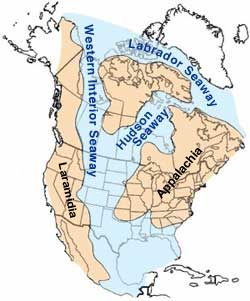Most schoolteachers and students don’t realize they are writing with fossils when they use chalk. Chalk consists of plankton, especially coccoliths, that mixed with mud millions of years ago. This lime-mud eventually fossilized, turning to stone. Chalk that became exposed to heat and pressure when buried deep under sediment metamorphized into marble–perhaps the most beautiful of natural building materials. The majority of chalk on earth formed during the late Cretaceous and early Paleocene between 100 million to 60 million years ago. Chalky soils are abundant in Mississippi and Alabama where the shrink-swell properties of this type of dirt help grass outcompete trees in black belt prairies. Parts of this black belt prairie extend into Georgia (See https://markgelbart.wordpress.com/2013/02/01/georgia-eocene-chalk-prairies/ ). Many Cretaceous-age vertebrate fossils are found in the black belt prairie region because it is located near the shoreline of what was the Western Interior Seaway, a body of water that existed during the Cretaceous and well into the Eocene era. An educational program in Alabama allows high school and middle school students to help paleontologists collect fossils there. Noah Taylor, a teenaged assistant, pointed out what he thought was a rock in a quarry paleontologists were excavating. It was more than just a rock–it was the backbone of an elasmosaurus.

Location of Greene County, Alabama where a skeleton of an elasmosaurus was recently found. The only fossil of a velociraptor found on the Appalachia side of the Western Interior Seaway was discovered here too.

Artist’s rendition of a couple elasmosaurii.
Scientist holding a bone of an elasmosaurus found by Noah Taylor. The caption of this photo from a news account claimed this was a backbone. I believe this is an error. It doesn’t look like a backbone but rather a limb bone.

This is what an elasmosaurus backbone looks like. All backbones look similar to this.

Map of North America during the Cretaceous. North America was separated into 3 island continents by shallow seas.
The Demopolis Chalk Formation in Greene County, Alabama usually yields marine fossils including those of turtles, crocodilians, sharks, fish, and sea shells. But occasionally a dinosaur died and was swept out to sea where its bones mixed with remains of marine organisms. Marine reptiles such as mososaurs and pleisiosaurs were predators and thus less common in the environment, explaining why their fossils are found but rarely. The elasmosaurus was a type of long-necked pleisiosaur. Its very long neck acted almost like a fishing pole. Its large body was probably camouflaged to look like the color of the sea, and its head, well away from its body, could rest patiently until an unwary fish swam close. Or perhaps they used their large body and paddles to herd fish toward their head. We’ll never know their exact hunting technique.
At this recent dig scientists found 15 out of the 70 vertebrae that made up the long neck of the elasmosaurus, and they also excavated paddle bones, though it’s not clear from news reports exactly how much of the long dead animal was recovered. No scientific paper about this find has been written yet. This is the second elasmosaurus skeleton found in Alabama; the other having been excavated in 1969.
The earth was a much different world during the Cretaceous. 85% of the planet was underwater. Frosts rarely, if ever, occurred anywhere. Everyday was like the hottest July day in Georgia. I sometimes fantasize about jumping in a time machine to live during the Pleistocene, but I would not want to live during the hellish Cretaceous.
